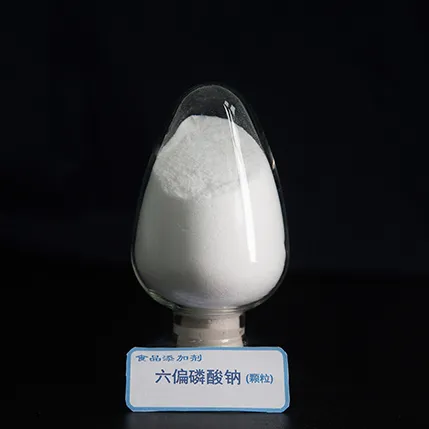Pendahuluan:
Selamat datang di dunia alkimia kuliner yang menggiurkan, di mana cita rasa melampaui hal yang biasa, dan setiap gigitan adalah simfoni rasa. Dalam perjalanan gastronomi ini, dunia natrium heksametafosfat yang penuh teka-teki, pahlawan tanpa tanda jasa di balik layar, memperkaya hidangan favorit kita dengan sentuhan keajaiban.
Bagian 1: Sodium Hexametaphosphate 101 - Pengantar Kuliner
Sebelum kita memulai perjalanan kuliner kita, mari kita berkenalan dengan natrium heksametafosfat. SHMP adalah sejenis natrium fosfat yang banyak digunakan dalam berbagai makanan. Meskipun namanya rumit, namun fungsinya cukup sederhana: meningkatkan kualitas hidangan favorit kita. Dari sudut pandang kimia, natrium heksametafosfat adalah polifosfat siklik, yang terdiri dari enam unit fosfat.
Bagian 2: Di Balik Layar - Bagaimana Sodium Hexametaphosphate Meningkatkan Rasa Makanan
Sekarang setelah kita bertemu dengan teman kuliner kita, mari kita jelajahi perannya dalam peningkatan rasa. Sodium hexametaphosphate bertindak sebagai agen pengkelat, mengikat ion logam yang dapat menyebabkan rasa tidak enak dan kerusakan. SHMP dapat menetralkan elemen-elemen ini dan membuat bahan-bahan menjadi lebih baik. Ini dapat menyesuaikan rasa makanan adalah bahan yang disukai untuk koki dan produsen makanan.
Bagian 3: Dari Pertanian hingga Garpu - Perjalanan Sodium Hexametaphosphate dalam Industri Makanan
Perjalanan kami membawa kami melewati jalur rumit natrium heksametafosfat dari asalnya hingga penggabungannya ke dalam berbagai produk makanan. Berasal dari asam fosfat, SHMP menjalani proses produksi yang sangat teliti untuk memastikan kemurnian dan kualitasnya.
Asam fosfat (seperti natrium kokas fosfat dan kalsium fosfat) biasanya digunakan sebagai asam vesik untuk produk yang dipanggang, dan gas karbon dioksida disediakan untuk proses pemanggangan dengan reaksi bikarbonat. Fosfat yang berbeda memiliki laju reaksi adonan (ROR) yang berbeda dan dapat dipilih secara wajar sesuai dengan efek pemanggangan yang diharapkan (volume, struktur pori, rasa). Sodium hexametaphosphate dapat digunakan sebagai pengatur tepung, peningkat adonan, penyangga, dan zat nutrisi ragi.
Bagian 4: Menjaga Kesegaran - Peran Sodium Hexametaphosphate dalam Masa Simpan Makanan
Sodium hexametaphosphate juga memiliki kinerja pelembab. Pada banyak makanan, hilangnya kelembapan adalah salah satu alasan utama pengeringan dan pengerasan makanan. Sodium natrium fosfat dapat menyerap dan mempertahankan air dalam makanan, menunda penguapan air, dan menjaga kelembapan dan rasa makanan. Hal ini sangat penting terutama pada makanan seperti kue, dan roti, membuatnya lebih lembut dan elastis.
Bagian 5: Seni Menyeimbangkan - Sodium Hexametaphosphate dalam Tekstur Makanan
Tekstur adalah aspek penting dari pengalaman kuliner, dan sodium hexametaphosphate adalah pahlawan tanpa tanda jasa dalam mencapai keseimbangan yang sempurna. Baik itu serpihan kue atau krim dari saus, SHMP berkontribusi pada keseluruhan rasa di mulut, memastikan bahwa setiap gigitan tidak hanya beraroma tetapi juga memuaskan dalam hal tekstur.
Bagian 6: Membuka Kedok Ilusi Kuliner - Sodium Hexametaphosphate dalam Makanan Olahan
Mari kita tarik kembali tirai pada makanan olahan dan menyingkap ilusi kuliner yang dibuat oleh natrium heksametafosfat. Dalam bidang makanan ringan dan makanan kemasan, SHMP bertindak sebagai penstabil, mencegah bahan makanan terpisah dan mempertahankan tekstur yang konsisten. Ini adalah tangan tak terlihat yang memastikan makanan ringan dan makanan praktis favorit Anda tidak hanya terasa enak tetapi juga terlihat dan terasa menggugah selera.
Kesimpulan:
Jelajahi perjalanan lezat natrium heksametafosfat bersama kami. Selanjutnya, kami akan mengeksplorasi pertimbangan diet, berbagi keterampilan praktis koki keluarga, dan mengungkap rahasia natrium heksametafosfat untuk membantu Anda meningkatkan keterampilan memasak.
Kesimpulan:
Jelajahi perjalanan natrium heksametafosfat bersama kami. Selanjutnya, kita akan mempelajari pertimbangan diet, berbagi keterampilan praktis dari koki keluarga, dan mengungkap rahasia natrium fosfat untuk meningkatkan keterampilan memasak Anda.
Konten Bonus:
Dalam tarian rasa yang rumit yang membentuk pengalaman kuliner kita, salah satu mitra yang sering diabaikan tetapi sangat penting adalah sodium hexametaphosphate (SHMP). Senyawa ini memastikan makanan favorit kita sampai di piring kita dengan kesegaran penuh.
Bagian 7: Perisai Terhadap Kerusakan
Pada intinya, natrium heksametafosfat berfungsi sebagai perisai yang tangguh terhadap pembusukan.
Sodium Hexametaphosphate, sebagai pengawet makanan, secara efektif dapat memperpanjang umur simpan makanan. Dalam proses pengolahan dan penyimpanan makanan, mikroorganisme seperti bakteri, jamur, dan ragi sering menjadi penyebab utama kerusakan makanan. Menambahkan Sodium Hexametaphosphate dalam jumlah yang tepat dapat menghambat reproduksi mikroorganisme, mencegah kerusakan makanan dan menjaga kesegaran dan kualitas makanan.
Bagian 8: Memperpanjang Umur Simpan
Salah satu fitur yang menonjol dari natrium heksametafosfat adalah kemampuannya untuk memperpanjang umur simpan produk makanan. SHMP mencegah pembentukan kristal yang tidak diinginkan, memastikan tekstur dan kualitas yang konsisten dalam makanan dari waktu ke waktu. Ini berkontribusi untuk memperpanjang kenikmatan produk-produk ini melampaui tanggal produksinya.
Bagian 9: Keserbagunaan dalam Aplikasi
Sodium heksametafosfat ditambahkan ke dalam produk susu untuk melindungi protein. Yang disebut "susu berkalsium tinggi" adalah menambahkan bubuk kalsium ke dalam susu (kalsium karbonat, kalsium laktat, dll., dan setiap produsen menambahkan secara berbeda) untuk meningkatkan kandungan kalsiumnya. Sebagai "benda asing", bubuk kalsium tidak larut dalam mikro. Itu harus diendapkan. Untuk memastikan bahwa itu tidak diendapkan, beberapa zat koloid harus ditambahkan. Zat-zat ini akan membentuk berbagai struktur jaring dalam mikro. Esensi Ini tampaknya stabil dan seragam. Peran setiap aditif berbeda. Gel Kara bagus (bahan baku utama jeli), tetapi terlalu banyak lengket akan mempengaruhi rasa. Selulosa mikrokristal (MCC) memiliki viskositas yang buruk. Mereka menggunakan efek suspensi di antara mereka.
Bagian 10: Mempertahankan Integritas Rasa
Mempertahankan kesegaran sejalan dengan menjaga integritas rasa, dan natrium heksametafosfat unggul dalam hal ini. Dengan mencegah perkembangan rasa yang tidak diinginkan yang disebabkan oleh oksidasi, ini memungkinkan rasa asli dari bahan-bahan tersebut bersinar. Hal ini membuat SHMP menjadi pilihan yang lebih disukai bagi produsen makanan yang ingin memberikan produk yang tidak hanya memiliki masa simpan yang lebih lama tetapi juga mempertahankan rasa lezat yang diharapkan konsumen.
Kesimpulan:
Di bidang kesegaran makanan, sodium hexametaphosphate muncul sebagai penjaga yang diam, memastikan bahwa kelezatan kuliner yang kita nikmati bukan hanya kenikmatan sesaat, tetapi juga pengalaman yang bertahan lama. Hal ini dapat mencegah kerusakan, memperpanjang umur simpan dan menjaga cita rasa tetap lengkap. Jadi, lain kali Anda menggigit kue yang segar dan menyenangkan atau menikmati kelembutan es krim favorit Anda, ingatlah bahwa natrium heksametafosfat bekerja di belakang layar untuk menjaga kesempurnaan.
Bagian Bonus: Pengolahan dan Pelunakan Air
Berikut adalah daftar pertanyaan umum dan jawabannya yang berkaitan dengan natrium heksametafosfat:
Pertanyaan 1: Apakah natrium heksametafosfat itu?
Jawaban 1: Sodium hexametaphosphate (SHMP) adalah senyawa kimia dengan rumus (NaPO3)6. Ini adalah garam natrium dari asam metafosfat dan umumnya digunakan dalam berbagai aplikasi industri dan makanan.
Pertanyaan 2: Apa tujuan utama natrium heksametafosfat dalam makanan
Jawaban 2: Dalam industri makanan, natrium heksametafosfat sering digunakan sebagai zat penyerap dan pengemulsi. Ini membantu meningkatkan tekstur makanan olahan, mencegah kristalisasi, dan meningkatkan umur simpan produk tertentu.
Pertanyaan 3: Apakah natrium heksametafosfat aman untuk dikonsumsi?
Jawaban 3: Ya, natrium heksametafosfat secara umum diakui aman (GRAS) oleh pihak berwenang bila digunakan sesuai dengan tingkat yang disetujui. Sodium Hexametaphosphat food grade dalam jumlah yang sesuai tidak berbahaya bagi tubuh manusia, tetapi jika tidak digunakan secara teratur, seperti dicampur dengan zat lain dan overdosis, penggunaan jangka panjang dapat berbahaya bagi tubuh manusia, dan keracunan serta fluorosidoskopi dapat terjadi.
Pertanyaan 4: Apakah natrium heksametafosfat memiliki manfaat bagi kesehatan?
Jawaban 4: Sodium hexametaphosphate terutama digunakan karena sifat fungsionalnya dalam aplikasi makanan dan industri. Meskipun tidak memberikan manfaat kesehatan secara langsung, perannya dalam menjaga kualitas makanan secara tidak langsung dapat berkontribusi dalam menjaga pola makan yang beragam dan bergizi.
Pertanyaan 5: Dapatkah individu dengan pantangan makanan atau diet khusus mengonsumsi produk yang mengandung natrium heksametafosfat?
Jawaban 5: Individu dengan pantangan makanan harus memeriksa label produk untuk mengetahui keberadaan natrium heksametafosfat. Meskipun secara umum aman, mereka yang memiliki masalah diet tertentu dapat memilih untuk membatasi asupannya berdasarkan preferensi individu atau pertimbangan kesehatan.
Pertanyaan 6: Bagaimana natrium heksametafosfat berkontribusi pada pengolahan air?
Jawaban 6: Sodium hexametaphosphate digunakan dalam pengolahan air sebagai agen penyerap. Ini berikatan dengan ion logam, mencegah pembentukan kerak pada pipa dan peralatan. Aplikasi ini membantu meningkatkan aliran air dan menjaga efisiensi sistem pengolahan air.
Pertanyaan 7: Jenis makanan apa yang umumnya mengandung natrium heksametafosfat?
Jawaban 7: Sodium hexametaphosphate ditemukan dalam berbagai makanan olahan, termasuk makanan yang dipanggang, produk susu, dan makanan ringan tertentu. Ini adalah bahan tambahan makanan yang umum digunakan, yang biasanya digunakan dalam makanan seperti produk daging, makanan beku, produk susu.
Pertanyaan 8: Apakah natrium heksametafosfat memiliki dampak terhadap lingkungan?
Jawaban 8: Dampak lingkungan natrium heksametafosfat umumnya dianggap rendah. Hal ini dapat mencegah kristal dan memperpanjang umur simpan produk.
Pertanyaan 9: Dapatkah natrium heksametafosfat digunakan dalam masakan rumahan?
Jawaban 9: Ya, natrium heksametafosfat dapat digunakan dalam masakan rumahan untuk tujuan tertentu. Juru masak rumahan yang tertarik untuk bereksperimen dengan senyawa ini harus mengikuti panduan yang direkomendasikan dan mempertimbangkan aplikasi yang diinginkan, seperti meningkatkan tekstur atau mencegah kristalisasi dalam resep tertentu.
Pertanyaan 10: Apakah ada potensi efek samping atau risiko yang terkait dengan penggunaan natrium heksametafosfat?
Jawaban 10: Ketika dikonsumsi dalam kadar yang direkomendasikan, sodium hexametaphosphate umumnya dianggap aman. Namun, asupan yang berlebihan dapat menyebabkan potensi risiko kesehatan. Bahan ini digunakan dalam jumlah yang relatif kecil dalam berbagai aplikasi dan diatur penggunaannya untuk meminimalkan potensi dampak lingkungan.
Bagian Bonus: 10 Tips Praktis Terkait Sodium Hexametaphosphate
Berikut ini adalah daftar singkat 10 tips yang terkait dengan natrium heksametafosfat:
Periksa Label Makanan: Bersikaplah proaktif dalam membaca label makanan untuk mengidentifikasi produk yang mengandung natrium heksametafosfat. Kesadaran ini membantu Anda membuat pilihan berdasarkan informasi tentang konsumsi makanan Anda.
Moderasi adalah Kuncinya: Meskipun natrium heksametafosfat secara umum aman, namun moderasi sangat penting. Seperti makanan lainnya, jumlah yang tepat dapat membuat kita lebih sehat. Kita membutuhkan makanan yang beragam untuk menghindari makanan olahan yang berlebihan.
Jelajahi Masakan Rumah: Jika Anda penasaran dengan natrium heksametafosfat, cobalah bereksperimen dengannya di dapur Anda sendiri. Ikuti panduan yang direkomendasikan untuk penggunaan, terutama dalam resep yang dapat meningkatkan tekstur atau mencegah kristalisasi.
Konsultasikan dengan Pembatasan Diet: Individu dengan pantangan makanan atau masalah kesehatan tertentu harus berkonsultasi dengan profesional kesehatan mereka tentang penyertaan natrium heksametafosfat dalam makanan mereka.
Memahami Pelunakan Air: Jika Anda berurusan dengan masalah air sadah, pertimbangkan penggunaan natrium heksametafosfat sebagai pelembut air. Memahami aplikasinya dalam pengolahan air dapat berkontribusi pada peningkatan kualitas air di rumah Anda.
Berhati-hatilah dengan Makanan Olahan: Makanan olahan sering kali mengandung natrium heksametafosfat untuk meningkatkan tekstur dan pengawetan. Harap kendalikan asupan Anda secara keseluruhan dari produk tersebut.
Mengawetkan Makanan yang Dipanggang di Rumah: Jika Anda senang membuat kue di rumah, jelajahi bagaimana natrium heksametafosfat dapat berkontribusi pada pengawetan kesegaran dan tekstur pada kue kering dan makanan panggang buatan sendiri.
Pertimbangkan Dampak Lingkungan: Pahami bahwa meskipun natrium heksametafosfat memiliki dampak lingkungan yang rendah, penggunaan dan pembuangan yang bertanggung jawab sangatlah penting. Ikuti panduan yang direkomendasikan untuk meminimalkan potensi dampak terhadap lingkungan.
Tetap Terinformasi: Terus ikuti perkembangan penelitian dan informasi terkini mengenai sodium hexametaphosphate.
Seimbangkan Kenyamanan dengan Pilihan Nutrisi: Meskipun nyaman, makanan olahan mungkin tidak selalu selaras dengan pilihan nutrisi yang paling sehat. Pertimbangkan untuk menyeimbangkan kenyamanan dengan makanan utuh yang kaya nutrisi untuk mendukung diet yang menyeluruh dan bergizi.
Kiat-kiat ini bertujuan untuk memberikan panduan praktis bagi individu yang menavigasi lanskap natrium heksametafosfat, baik dalam pilihan makanan, upaya memasak, atau pertimbangan untuk pengolahan air.
Bagian 11: Ringkasan Rincian Natrium Heksametafosfat
Sodium hexametaphosphate (SHMP) adalah senyawa kimia dengan rumus kimia (NaPO₃)₆. Ini adalah garam natrium dari asam metafosfat dan umumnya digunakan untuk berbagai aplikasi industri, pengolahan air, dan aplikasi yang berhubungan dengan makanan. Berikut adalah beberapa detail tentang natrium heksametafosfat:
Bagian 12: Komposisi Kimia
Kandungan Total Fosfat:
Sodium hexametaphosphate terdiri dari enam unit fosfat dalam struktur siklik, yang direpresentasikan sebagai (NaPO₃)₆. Kandungan total fosfat dihitung berdasarkan jumlah gugus fosfat dalam rumus molekul.
Kandungan Fosfat Tidak Aktif:
Istilah "fosfat tidak aktif" mengacu pada bagian dari gugus fosfat yang tidak secara langsung terlibat dalam penyerapan ion logam atau reaksi kimia lainnya. Kandungan pasti fosfat tidak aktif dalam natrium heksametafosfat dapat bervariasi berdasarkan proses pembuatan dan aplikasi yang dimaksudkan.
Bagian 13: Nilai pH
Nilai pH:
Nilai pH natrium heksametafosfat dapat bergantung pada konsentrasi larutan dan kondisi spesifik yang diukur. Umumnya, dalam larutan air, natrium heksametafosfat bersifat basa, yang berkontribusi pada peningkatan pH. Bagian 14: Informasi Tambahan
Penampilan:
Sodium hexametaphosphate sering ditemukan dalam bentuk bubuk atau butiran kristal putih. Penampilan fisiknya dapat bervariasi berdasarkan faktor-faktor seperti kemurnian dan metode pembuatan.
Kelarutan:
Sodium hexametaphosphate larut dalam air, membentuk larutan jernih. Tingkat PH dapat dipengaruhi oleh keberadaan suhu dan zat lain dalam larutan.

